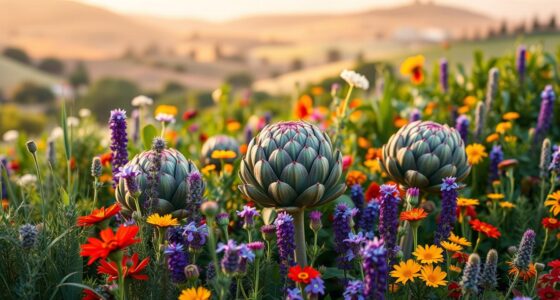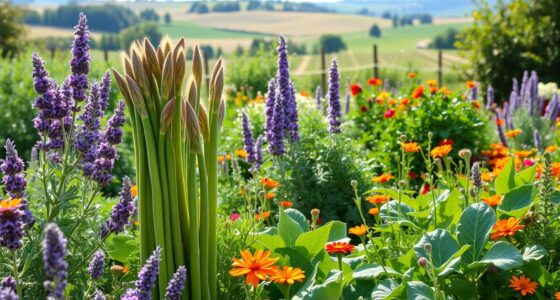To attract ladybugs and other beneficial insects, plant herbs like dill, fennel, and coriander near your garden. Bright flowering plants such as marigolds also help lure them in with their scents and colors. These plants provide natural food sources and shelter, encouraging helpful insects to stay and hunt pests like aphids. Incorporating a mix of flowering plants and herbs creates a thriving ecosystem. Keep going to discover more tips on designing your garden for maximum pest control.
Key Takeaways
- Plant aromatic herbs like dill, fennel, and coriander to naturally attract ladybugs seeking prey.
- Incorporate flowering plants such as marigolds to provide visual cues and scent attractants for beneficial insects.
- Use a diverse mix of flowering plants, herbs, and vegetables to ensure continuous nectar and pollen sources.
- Position attractant plants near pest-prone areas to draw ladybugs directly to pests and enhance pest control.
- Strategically time and place these plants to create an inviting environment that supports beneficial insect populations.

Have you ever wondered how ladybugs can be so effective at attracting certain pests? The secret lies in the plants you choose to grow around your garden. By selecting specific plants, you can naturally draw beneficial insects like ladybugs, which play a vital role in pest control strategies. Instead of relying solely on chemical pesticides, adopting organic gardening techniques allows you to create a balanced ecosystem where beneficial insects thrive, helping you manage pests more sustainably.
Certain plants emit scents that attract ladybugs and other helpful insects. For instance, dill, fennel, and coriander produce aromatic compounds that draw ladybugs in search of their favorite prey—aphids and other soft-bodied insects. By planting these herbs near your vegetable beds or flowering areas, you can encourage ladybugs to settle in and patrol for pests. This method not only reduces the need for chemical interventions but also enhances the overall health of your garden.
Marigolds are another excellent choice because they produce a scent that attracts a range of beneficial insects, including ladybugs. Their bright colors act as visual cues that lure insects to your garden. Incorporating these flowers into your landscape can create a natural barrier against pests, aligning perfectly with organic gardening techniques aimed at promoting biodiversity and ecological balance.
Plant diversity is key when trying to attract beneficial insects. Including a mix of flowering plants, herbs, and flowering vegetables can provide a continuous source of nectar and pollen, which sustains ladybugs and other helpful insects throughout different stages of their life cycles. This constant food supply makes your garden more resilient against pest invasions and less dependent on chemical controls.
Timing and plant placement are also important. Positioning these attractant plants near problem areas ensures that ladybugs and other beneficial insects are drawn directly to where pests are likely to gather. By doing so, you create an inviting environment that naturally suppresses pest populations without disrupting your garden’s ecological harmony.
Frequently Asked Questions
Do Ladybugs Prefer Certain Plant Species Over Others?
You might wonder if ladybugs prefer certain plant species over others. Generally, they are attracted to plants with abundant aphids, like dill, fennel, or yarrow, which offer insect attraction and food sources. While ladybugs don’t have strict plant preferences, planting a variety of beneficial plants can encourage their presence. Choose plants that support insect attraction, and you’ll create a welcoming environment for ladybugs to thrive and help control pests naturally.
How Long Does It Take for Ladybugs to Find the Lures?
You might wonder how long it takes for ladybugs to find the lure. Ladybug behavior varies, but generally, they’re quick to notice lure visibility, especially if the scent mimics their natural prey or habitat. Usually, within a few hours to a couple of days, ladybugs start investigating the area. Keep the lure well-placed and attractive, and you’ll see ladybugs respond faster, aiding your pest control efforts effectively.
Can Ladybugs Be Attracted to Non-Native or Ornamental Plants?
Did you know that ladybugs are attracted to plants based on scent and visual cues? They can indeed be drawn to non-native or ornamental plants if these plants emit the right signals. While native plants typically attract more beneficial insects, ornamental plants with specific appeal can also serve as effective non native plant attraction points for ladybugs. Your garden’s plant choices might influence ladybug presence more than you realize.
Are There Specific Environmental Conditions That Enhance Lure Effectiveness?
You can enhance lure effectiveness by considering microclimate factors like temperature, humidity, and sunlight, which influence ladybug activity. Seasonal variations also play a role; for instance, ladybugs are more active in warmer months. By selecting planting sites with ideal microclimate conditions and timing your plantings to seasonal peaks, you’ll attract more beneficial insects and boost your garden’s pest control naturally.
How Often Should I Renew or Replace Ladybug Lures?
You should monitor your ladybug lures regularly, checking their lure longevity and renewal frequency. When the lures start fading, losing scent, or becoming less attractive, it’s time to replace them. Typically, renewal should happen every few weeks to maintain effectiveness, but environmental factors like weather can influence this. By staying attentive and renewing as needed, you ensure your lures consistently attract beneficial insects and protect your garden.
Conclusion
Think of ladybug lures as a secret garden that beckons helpful friends to your plants. By planting the right blooms, you create a welcoming oasis where these beneficial insects naturally arrive, like a gentle tide washing over your garden. Embrace this simple magic, and watch your garden flourish with less effort and fewer pests. It’s your personal symphony of harmony—nature’s way of working together in perfect tune. Let your garden’s story be one of thriving life and balance.









